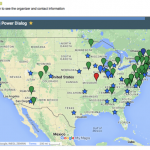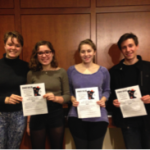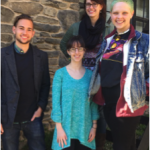The week of April 4th, 2016, over a thousand of students from more than fifty colleges and universities in twenty state capitals participated in Power Dialog forums with state officials and other experts. The focus: state policy efforts to cut global warming pollution, and support the US commitment to reduce emissions that was made in Paris last December. Power Dialogs were held in red, blue and purples states, including in Texas, Arizona, Georgia, Alabama, North Carolina, Virginia, Pennsylvania, Nebraska, Indiana and also New Hampshire, Michigan, New York, Maine, Maryland, Minnesota, Massachusetts , Colorado, Oregon, Washington and Hawaii.
 These were not advocacy events, rather, opportunities for students to hear directly from top state policy makers, and participate in informed dialog. The core idea was that state officials are interacting regularly with coal industry lobbyists, utility executives and environmental groups. But they have not spoken with or heard from the most critical stakeholders of all—the young people who will be alive in 2050 and beyond to experience the impacts of our action, or inaction, today.
These were not advocacy events, rather, opportunities for students to hear directly from top state policy makers, and participate in informed dialog. The core idea was that state officials are interacting regularly with coal industry lobbyists, utility executives and environmental groups. But they have not spoken with or heard from the most critical stakeholders of all—the young people who will be alive in 2050 and beyond to experience the impacts of our action, or inaction, today.
Photo: Head of the Air Division, New York DEC, Jared Snyder with student panelists at the University at Albany, NY State Power
The national Power Dialog initiative was initially conceived, organized and coordinated by a team including staff and graduate and undergraduate students at the Center for Environmental Policy at Bard College. The Bard organizers recruited university-based teams to host the state capital dialogs, some headed up by students, others by faculty, and others by staff. Bard CEP Director Goodstein spoke on some thirty campuses during the fall and early winter to encourage the formation of Power Dialog teams. The project steering committee included David Blockstein, Senior Scientist at the National Council on Science and the Environment; Dallas Burtraw, Senior Research Fellow at Resources for the Future, and Debra Rowe, President of the U.S. Partnership for Education for Sustainable Development.
To help students prepare for their state dialogs, the national project provided educational resources and sponsored a series of six webinars in the early spring with leading climate experts. The web-based resources (www.powerdialog.net) and webinars focused on topics including public health, jobs and employment, and environmental justice impacts of climate policy, different state policy options (efficiency, renewables, carbon pricing), the opportunity for interstate cooperation in designing pollution control systems, and the international dimensions of US climate action. Resources for the Future provided a link to a special collection of resources they had produced on state climate policy. Webinars each attracted around 25-30 viewers live, plus students in the Bard graduate program, and then were posted on-line for recorded viewing.
 The Power Dialog was originally conceived with a laser-like focus on State Implementation Planning for the Clean Power Plan. Under the Power Plan, climate policy was suddenly live in every state in the country, with an actual, identifiable person (typically at the state DEC or DEQ) in charge of planning for cutting global warming pollution in each state. Given this, the dialogs could move beyond the highly politicized, partisan rhetoric that has characterized public conversation about climate change throughout the lives of todays’ students. Instead, young people could witness first-hand the “roll-up-the sleeves” approach that, outside of the political arena, is in fact typical of much state level planning on energy and air pollution control.
The Power Dialog was originally conceived with a laser-like focus on State Implementation Planning for the Clean Power Plan. Under the Power Plan, climate policy was suddenly live in every state in the country, with an actual, identifiable person (typically at the state DEC or DEQ) in charge of planning for cutting global warming pollution in each state. Given this, the dialogs could move beyond the highly politicized, partisan rhetoric that has characterized public conversation about climate change throughout the lives of todays’ students. Instead, young people could witness first-hand the “roll-up-the sleeves” approach that, outside of the political arena, is in fact typical of much state level planning on energy and air pollution control.
The organizing model for the Power Dialog leaned on the behavioral economic approach developed by Heath and Heath (2010). To simplify, the authors argue that any initiative to mobilize widespread action, to get people to do something new, should be perceived by potential participants as (1) effective, (2) exciting, and (3) (relatively) easy. “Effective” means high impact: does the project generate a return justifying the participant’s time? “Exciting” means motivating: will folks work and turn out for this? “Easy” is a critical feature in a world where educators have very limited bandwidth.
Because the CPP mandated public outreach on the part of state officials in their planning, the project was easily understood as effective: students would have a chance to weigh in with top policy makers on a live planning process, with critical real world decisions on the table. Working with colleagues (students, faculty and staff) across the state would be fun. And finally, the Power Dialog model was designed to be simple to organize. First, invite the state officials in charge of CPP implementation, because they had to show up. Second, have designated students on stage to lead a lively dialog. With top state officials on the hook both to talk and listen, a state-wide audience, including a media audience, was guaranteed.
This organizing model focused around the CPP was initially working well. In early February of 2016, the project had commitments from organizers in thirty states to host Power Dialogs, with strong leads in another ten. Andy Revkin at the NY Times became interested in the project, and covered it in his DotEarth blog. However, in a surprise move on February 9, the Supreme Court placed a stay on the Clean Power Plan. State officials in most red and purple states were immediately directed by their governors to close their spreadsheets. In these states, officials were no longer obligated to attend, or interested in attending, our Power Dialogs.
Over night, the Power Dialogs went from forums with a focus on critical live policy decisions to being academic policy discussions, losing much of their perceived immediacy, effectiveness, and media interest. And in red and purple states, the dialogs went from being easy to organize to being pretty hard to pull together. The designated, high-profile speaker no longer had an incentive to show up, and so organizing teams had to scramble to find alternates. And with the CPP no longer on the table, audience interest declined, so organizers had to work much harder to promote their events.
In spite of the challenges, the Power Dialogs that were held were individually and collectively a success. The biggest events were in Pennsylvania (attendance 230), New York (attendance 300), Virginia (200) and Minnesota (200). In these states, 6-12 colleges and universities were represented. Other state events ranged in size from twenty students attending to seventy-five. At some events, there were workshops held in advance of the dialog, and in all, a conversation with the top officials in the state. Student Q&A was informed, challenging, and productive, and both students and regulators left with a sense of strengthened engagement in their state initiatives.
 Two Power Dialog events were organized solely by students: at Macalaster College in Minnesota, and at Boston University in Massachussetts. Jack McCarthy, one of the Macalaster student organizers reported: “It couldn’t have gone better! We had a great panel and students loved it. We’d love to do it again now that we’ve established the connections.”
Two Power Dialog events were organized solely by students: at Macalaster College in Minnesota, and at Boston University in Massachussetts. Jack McCarthy, one of the Macalaster student organizers reported: “It couldn’t have gone better! We had a great panel and students loved it. We’d love to do it again now that we’ve established the connections.”
Photo: Macalaster student organizers.
In North Carolina, a class taught by Professor Dedee Johnson organized a “deliberative dialog” in which students and stakeholders representing diverse perspectives worked in small, facilitated groups to discuss potential directions for the state. In Arizona, students from the University of Arizona partnered with colleagues at Arizona State to hold a round-table conversation with state policy experts. One of the parting suggestions was to hold a Power Dialog conversation with students on an annual basis.
Maine’s Power Dialog, hosted by Unity College, featured a conversation with Republican Governor Paul LePage. Not a friend of renewables, the Governor nevertheless had a civil conversation discussing his perspective with students. And this week, a solar bill is on his desk.
In Georgia, Agnes Scott College partnered with Emory Univesity to organize the Dialog, and in Alabama, the event was led by Birmingham- Southern College. In the Pacific northwest, Dialogs were held at Evergreen State College in Olympia, and at Willamette University in Salem, with an audience of 75 students.
To summarize: working off the promising opportunity created by the Clean Power Plan, the Power Dialog project got off to a strong start, making significant progress towards the goal of a fifty-state event. However, in early February, the project experienced an unanticipated setback in the form of the Supreme Court stay. This led to a reduction in the number of dialogs nationwide, the size of audiences for both the lead-in webinars and the dialogs, and a failure of the Dialogs once held to attract much media coverage.
In spite of this, the Dialog process confirmed the value of the underlying organizing model, and in fact, created a robust climate conversation in twenty states that would otherwise not have happened. The format worked well for those who adopted it, and many students attending found the opportunity to engage directly with top policy makers walked away inspired and wanting to become more involved. Well-designed coordinated national educational initiatives can create opportunities for educators to move beyond the “classroom as usual” and get students engaged directly with climate solutions in their communities.
At the Bard Center for Environmental Policy, we were encouraged by the results, and intend to continue to deliver on the promise of coordinated climate education. The organizing principles of “effective, exciting, and easy” will continue to guide our initiatives. Along these lines, for the fall semester of 2016, we are planning to sponsor what we are calling the “Politics and Environment Education Project”. (P&E Education Project)
Next autumn, educators across the country will be looking for a non-partisan way to engage students in a  deeper understanding of the relationship between Politics and the Environment. To support that interest, the project will develop learning opportunities that focus on the history of politics and the environment in the US: the period of national bi-partisan compromise and US leadership (1964-1992); the period of rising gridlock and partisanship at the national level, on the one hand, but also state and business sustainability leadership on the other (1994-2016); and the prospects for future political action. The overall focus will be on the importance of student engagement with the political process. At the conclusion of P&E events, students will be provided opportunities to get involved with their campus voter registration drive.
deeper understanding of the relationship between Politics and the Environment. To support that interest, the project will develop learning opportunities that focus on the history of politics and the environment in the US: the period of national bi-partisan compromise and US leadership (1964-1992); the period of rising gridlock and partisanship at the national level, on the one hand, but also state and business sustainability leadership on the other (1994-2016); and the prospects for future political action. The overall focus will be on the importance of student engagement with the political process. At the conclusion of P&E events, students will be provided opportunities to get involved with their campus voter registration drive.
Photo: Bard Organizing Team
To this end, the P&E Education Project will:
- Produce a recorded webinar with this specific historical focus.
- Establish a national speaker’s network of dozens of academics interested in speaking on college campuses on this topic.
- Sponsor a fall webinar series on P&E broadly.
- Offer additional on-line resources.
P&E has the key components required of our organizing model. The “effective” feature of P&E will be the explicit goal of involving student attendees with their campus voter registration movement. The “exciting” feature is the focus on the hot topic for the fall: the elections. And the “easy” feature will be the availability of local experts listed on our website willing to give the P&E talk.
P&E will provide a second test of Bard CEP’s model of national, collaborative climate education. If P&E is effective, then 2017-18 may provide the possibility for Power Dialog II. On the current timeline, and depending on the fall election outcome, the Supreme Court is likely to give the go-ahead for the Clean Power Plan in the fall of 2017. Again, climate policy will be live in all fifty states, presenting the opportunity for a second bite at a truly national dialog in April 2018, between students and top state officials on reducing global warming pollution. By 2018, the five-year follow-on to Paris will be only two years away, providing additional urgency to student engagement with climate state-level climate solutions.
A key to fully realize the potential for a Power Dialog II in 2017-18 will be adequate funding. In this cycle, we were not in fact able to raise the budget that we believed was necessary to achieve our goal of 10,000 students engaged in a 50-state event. We were surprised that several major funders we approached were reluctant to invest in serious stakeholder engagement by young people in support of strong state policy. Nevertheless—even with very limited staff support and unexpected negative headwinds—we demonstrated the success of the model to mobilize hundreds of students in select states, and dozens in many others, to engage in powerful face-to-face dialog with top officials.

